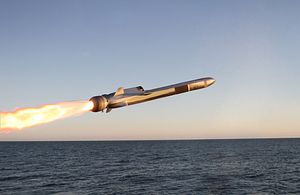The U.S. Marine Corps (USMC) and U.S. Navy (USN) are considering deploying a shore-based variant of the fifth-generation over-the-horizon Naval Strike Missile (NSM), according to James Geurts, assistant secretary of the U.S. Navy for Research, Development & Acquisition (RD&A)
Geurts spoke at the 2020 National Navy Surface Association Symposium in Crystal City, Virginia, earlier this week. “It’s certainly something we’re looking at closely,” Geurts was quoted as saying during a media briefing by Jane’s on January 15.
It is unclear what the USMC will use as a launcher. One possibility is an adapted High Mobility Artillery Rocket System (HIMARS), a truck-mounted launching platform that the USMC already employs.
The USMC tested firing HIMARS from the deck of an amphibious assault ship against shore targets in 2017. The NSM could be deployed in a similar manner.
The USMC would not be the first service to deploy a shore-based variant of the NSM. Poland’s military already fields a mobile, ground-based coastal defense version of the missile.
As I reported earlier this year, the NSM is capable of passively detecting its targets:
The NSM is the successor to Kongsberg’s Penguin short-to-medium range anti-ship guided [cruise] missile. The missile, featuring an imaging IR-seeker and inertial/GPS navigation, can strike both sea and land targets at a distance of around 185 kilometers (100 nautical miles). Carrying a 125-kilogram (276 pounds) multi-purpose blast/fragmentation warhead, the NSM is capable of reaching high subsonic speeds and can approach its targets in sea skim mode.
In 2019, the U.S. Navy deployed the Independence-class littoral combat ship (LCS) USS Gabrielle Giffords to the Indo-Pacific region carrying the NSM. As I noted at the time:
The NSM is reportedly being installed on the deck of each LCS in proprietary canister launchers.
Each LCS can be armed with up to eight NSMs. Overall, the U.S. Navy intends to procure 64 NSMs by 2023 with follow-on orders expected. It is unclear how many NSMs the USS Gabrielle Giffords carries for the duration of the warship’s deployment to the Indo-Pacific region.
Norway-based Kongsberg Gruppen and U.S. missile maker Raytheon Company were selected last year by the USN to install the NSM aboard most LCSs by 2023. The NSM is the USN’s first new anti-ship missile in decades.
As my colleague Steve Stashwick has pointed out, the NSM could be incorporated into USMC expeditionary concepts the service tested last year in the “Pacific Blitz” exercise.
“In the exercise, marines practices raiding and seizing islands, and establishing temporary bases to support supply, rearming, and repairs for aircraft,” Steve writes. “A mobile battery of [NSMs] would both help defend those bases from being attacked by an adversary’s warships as well as providing a bubble of sea control that would make an adversary navy’s movement and freedom of action more difficult.”

































